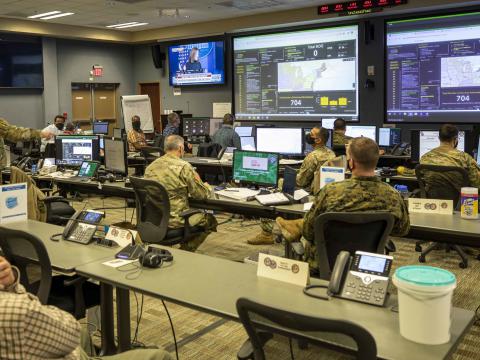DISA Goes All-In on Data-Centricity
As part of its planned transformation into a data-centric enterprise, the Defense Information Systems Agency will leverage telemetry and other data collected from endpoints to improve user experience, DISA officials said during an AFCEA International webinar.
“We are a giant generator of programmatic, technical and telemetry data,” said Bart Aimone, technical director of the Endpoint Services and Customer Support Directorate (ECS), which provides help desk support and cloud-based services to users in the U.S. Defense Department’s so-called Fourth Estate—defense agencies, like the Defense Intelligence Agency for instance—that are not part of one of the military services.
“Our focus is on the endpoint user and the customer experience, and we really want to be able to leverage that information and make it available inside the agency to be actionable … to enable our endpoint users and enhance their customer experience,” Aimone said.
He spoke at an April 13 webinar—the fourth of a four-week series where DISA officials have previewed their acquisition and policy priorities ahead of the annual TechNet Cyber conference April 26-28 in Baltimore. The April 13 webinar explored the third line of effort in DISA’s Strategic Plan: “Leverage Data as the Center of Gravity.”
Caroline Kuharske, DISA’s recently appointed acting chief data officer, opened the event by outlining the five “untapped efficiencies” that the agency had to realize “to get to an effective and mature data and information environment.”
- Data as an Asset—“Really investing in data as a strategic, tangible asset,” Kuharske said, means using tools for the discovery and cataloging of data and applying “robust cyber analytic processes to use that data with our tools, to create reports or automation and innovation programs through that data.”
- Data Architecture—“Transparency is key,” she said, “developing an architecture that enables data sharing.” As a service provider, DISA also had to be a data provider to the agencies it was partnering with to provide capabilities to the warfighter, Kuharske added. That data can be used “for cyber and business analytics.”
- Advanced Analytics—“It's not that we need more data; what we need is better data,” she offered. Advanced analytics turns data into actionable intelligence, which could be “provided to our watch officer, to the operations community and to our mission partners in a way that it's easy for them to understand and use for their own tasks.”
- Cyber Situational Awareness—One of the most important data streams that DISA provided, Kuharske said, “And we're partnering with a lot of our operational elements here in the agency to ensure that they are able to use that data within the agency for that cyber situational awareness monitoring strategy, and really optimizing that defense cyber data call.”
- Building a Data-Centric Culture—This means empowering the workforce, she stated. “We need to give them better tools. We need to really promote our collaboration programs and tools that [are part of DISA’s enterprise offerings]. So instead of sending a document back and forth through email, why don't we use our collaboration tools such as DEOS [Defense Enterprise Office Solution]?”
Aimone acknowledged that as agencies transitioned to DoDNet—the Network-as-a-Service that DISA provides to Fourth estate agencies—they might experience a loss of control. DISA had to make up for that by providing rich, actionable data to agency ops centers, he said.
The Defense Technical Information Center (DTIC) was the first Fourth Estate agency “to onboard to DoDNet,” stated Aimone. “They are giving up that strategic and tactical control of their local network, but they still have a mission need. They still need to have an understanding of what's happening within their [IT] environment. And being able to be transparent with that information back to the senior executives for that organization is critical for us, and we have to find a way to better make that data available,” he offered.
Over the next few years, the number of users of DoDNet will grow to more than 550,000, Aimone said.
“At that scale, it becomes harder to [employ] users as a sensor,” he noted, referring to an enterprise IT strategy that relies on user complaints or help desk tickets to measure the impact of changes to the network technology stack.
Instead, DISA planned to use rich data to get ahead of possible problems, he said. “With our data and our telemetry we get from the endpoints and from our transport components, we can see and be able to head off problems ahead of time.”




Comments